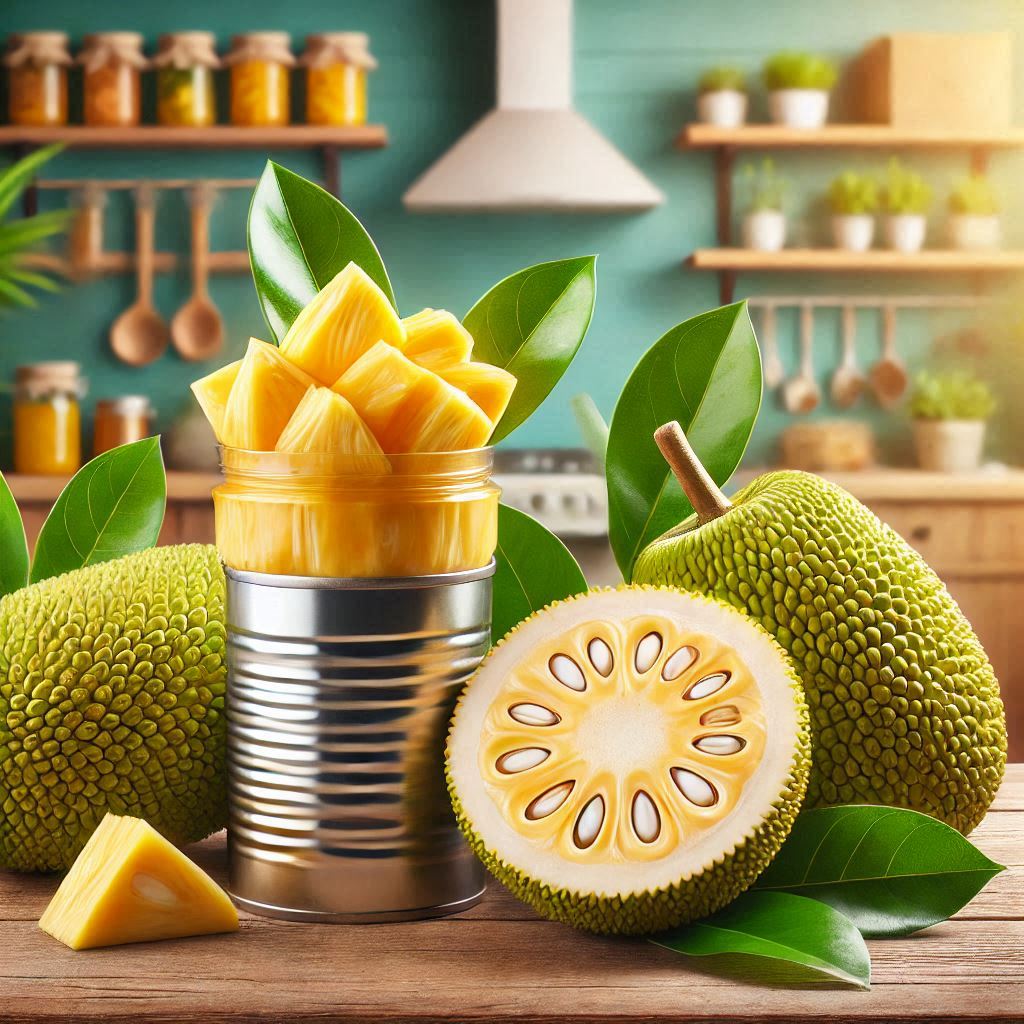
Understanding the Differences: Canned vs. Fresh Jackfruit
When it comes to incorporating jackfruit into your diet, understanding the differences between canned and fresh varieties is essential. Both options offer unique benefits and can be used in a variety of culinary applications.
Canned jackfruit is often prized for its convenience. It comes pre-prepared, saving you the time and effort required to peel, core, and cut a fresh jackfruit—a task that can be quite daunting given the fruit’s large size and sticky sap. The canned version is typically packed in brine or syrup, making it ready to use straight from the tin. This makes it an excellent choice for those who want to quickly add a tropical flair to their meals without much preparation.
On the other hand, fresh jackfruit provides a more authentic taste and texture experience. When ripe, its sweet flavor resembles a blend of mango, banana, and pineapple—perfect for desserts or snacking on its own. Unripe fresh jackfruit has a mild taste similar to artichoke hearts or hearts of palm when cooked; it’s often used as a meat substitute in savory dishes due to its fibrous texture.
The primary differences between canned and fresh jackfruit lie in their preparation requirements and flavor profiles. While canned fruit offers unparalleled convenience with consistent availability year-round, fresh jackfruit delivers superior taste quality when you have access to this exotic fruit.
Ultimately, whether you choose canned or fresh depends on your cooking needs—whether you’re prioritizing ease of use or seeking an authentic culinary experience with this versatile ingredient.
The Taste Test: Flavor Profiles of Canned and Fresh Jackfruit
When it comes to exploring the diverse flavors of jackfruit, conducting a taste test between canned and fresh varieties can reveal intriguing differences. Jackfruit, known for its unique texture and versatility, offers distinct flavor profiles depending on its form.
Starting with fresh jackfruit, you’ll find that it boasts a sweet and tropical flavor reminiscent of a blend between mango and banana. The ripe fruit is juicy and fragrant, with a hint of floral notes that make it an exotic addition to any dish. Its texture is fibrous yet tender, providing a satisfying bite whether consumed raw or cooked.
In contrast, the flavor profile of canned jackfruit tends to differ due to the preservation process. Often packed in syrup or brine, canned jackfruit may have a slightly muted sweetness compared to its fresh counterpart. The syrup can add an extra layer of sugary taste, while brined versions might carry a subtle tanginess. Texturally, canned jackfruit is softer and more pliable, making it ideal for absorbing flavors in savory dishes such as vegan pulled “pork.”
Understanding how jackfruit tastes in both forms allows culinary enthusiasts to choose the right type for their recipes. Whether you’re seeking the vibrant sweetness of fresh fruit or the convenience and adaptability of canned options, each has its own unique appeal that can enhance your culinary creations.
Nutritional Comparison: Canned Jackfruit vs. Fresh Jackfruit
When comparing the nutritional value of canned jackfruit to fresh jackfruit, it’s important to understand the differences in their nutrient profiles and how they might impact your health. Fresh jackfruit is a tropical fruit known for its impressive array of nutrients. It is rich in vitamins such as vitamin C, which supports immune function, and contains significant amounts of potassium, which helps regulate blood pressure. Additionally, fresh jackfruit provides dietary fiber that aids digestion and promotes a feeling of fullness.
On the other hand, canned jackfruit offers convenience but may differ nutritionally due to processing methods. The canning process often involves adding preservatives or syrup, which can increase sugar content and reduce some nutritional benefits compared to its fresh counterpart. However, canned jackfruit still retains many beneficial nutrients like carbohydrates for energy and small amounts of protein.
When considering health benefits between canned vs. fresh jackfruit, it’s essential to read labels carefully if opting for the canned variety—choosing those packed in water rather than syrup can help minimize extra sugars. While both forms offer unique advantages depending on dietary needs and lifestyle preferences, incorporating either into your diet can contribute positively when consumed as part of a balanced diet rich in fruits and vegetables.
Cooking with Jackfruit: Recipes and Uses for Both Varieties
Jackfruit, a versatile and nutrient-rich fruit, has gained popularity in kitchens around the world for its unique texture and ability to absorb flavors. Whether you’re cooking with canned or fresh jackfruit, this tropical delight can be transformed into a variety of delicious dishes.
When it comes to canned jackfruit, it’s typically young and green, making it an excellent meat substitute in vegan recipes. Its fibrous texture mimics pulled pork or chicken when cooked with the right spices. For a simple yet satisfying dish, try making BBQ jackfruit sandwiches. Drain and rinse the canned jackfruit before sautéing it with onions, garlic, and your favorite barbecue sauce until it’s tender and flavorful.
On the other hand, fresh ripe jackfruit is sweet and can be used in desserts or eaten on its own. To prepare fresh jackfruit for savory dishes like curries or stews, select an unripe fruit. It’s important to oil your knife before cutting into a fresh jackfruit due to its sticky sap. Once you’ve removed the pods from their fibrous casing, they can be cooked similarly to canned varieties.
For those looking to explore vegan recipes using jackfruit beyond BBQ dishes, consider crafting a spicy jackfruit taco filling by simmering shredded young jackfruit with chili powder, cumin, lime juice, and vegetable broth until well combined. Another delightful option is creating a hearty curry by simmering chunks of fresh young jackfruit in coconut milk along with curry paste and vegetables.
Regardless of which variety you choose—canned or fresh—jackfruit offers endless possibilities for creative culinary exploration while catering to both vegan diets and adventurous palates alike.
Sustainability and Accessibility: Which is the Better Choice?
When it comes to choosing between sustainability and accessibility in our eating habits, the decision isn’t always straightforward. Sustainable eating choices often prioritize fresh, locally sourced produce that supports environmental health by reducing carbon footprints and minimizing packaging waste. However, these options may not always be accessible to everyone due to factors like geographical location, availability, and cost.
On the other hand, canned produce offers a more accessible alternative for many people. It is widely available year-round and often more affordable than its fresh counterparts. Canned goods also have a longer shelf life, which can reduce food waste—a significant aspect of sustainable living.
Yet, there are environmental considerations with canned products as well. The production and transportation of canned goods can contribute to greenhouse gas emissions and energy consumption. Additionally, packaging materials like aluminum cans or plastic linings may pose recycling challenges.
Ultimately, the choice between sustainability and accessibility might not be about picking one over the other but finding a balance that suits individual circumstances while considering broader environmental impacts. By being mindful of both sustainable practices and accessibility needs, individuals can make informed decisions that support their health goals without compromising on environmental responsibility.






